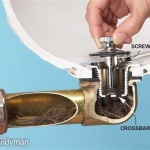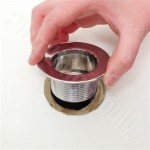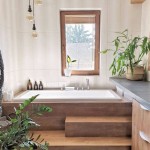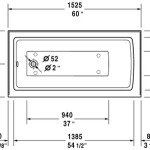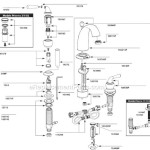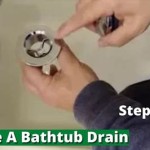Bathtub Overflow Cover Plate: Function, Types, and Maintenance
The bathtub overflow cover plate is a seemingly minor, yet critically important, component of a bathtub’s plumbing system. Its primary function is to prevent water from overflowing the tub, thereby avoiding potential water damage to surrounding walls, floors, and ceilings. While often overlooked, understanding the purpose, different types, and proper maintenance of the overflow cover plate can contribute significantly to the longevity and efficiency of a bathroom's plumbing.
Water damage resulting from bathtub overflows can be costly and disruptive. It can lead to the growth of mold and mildew, structural damage to building materials, and the need for extensive repairs. A properly functioning overflow cover plate acts as a safeguard against these potential hazards, protecting both the physical structure of the home and the health of its occupants.
Understanding the Function of the Bathtub Overflow System
The bathtub overflow system consists of several interconnected parts, all working in concert to prevent overflows. The most visible element is the overflow cover plate, typically a circular or rectangular plate located near the top of the bathtub, close to the drain on the opposite side. Behind this plate lies a crucial component: the overflow pipe. This pipe is connected to the main drainpipe and provides an alternative route for water to escape when the water level rises above a certain point.
When the water level in the bathtub reaches or exceeds the opening of the overflow cover plate, the excess water flows into the overflow pipe. This water then travels down the pipe and connects with the main drainpipe, ultimately exiting the plumbing system and preventing the bathtub from overflowing onto the bathroom floor. The design ensures that water is redirected safely, even if the main drain is partially or fully blocked.
The overflow system’s effectiveness relies on several factors. First, the overflow pipe must be clear and unobstructed. Any buildup of hair, soap scum, or other debris can restrict water flow, diminishing the system's capacity to handle excess water. Second, the connection between the overflow cover plate and the overflow pipe must be secure. A loose or damaged connection can lead to leaks behind the wall, which may not be immediately apparent but can cause significant water damage over time.
Furthermore, some overflow cover plates incorporate a drain stopper mechanism. This stopper, often operated by a lever or knob connected to the cover plate, allows the user to control whether the bathtub drain is open or closed. When closed, the stopper prevents water from draining, allowing the tub to fill. When open, the stopper allows water to drain freely. This added functionality makes the overflow cover plate an integral part of the bathtub's filling and draining process.
Types of Bathtub Overflow Cover Plates
Bathtub overflow cover plates are available in a variety of styles and materials to suit different bathtub designs and aesthetic preferences. The primary function remains the same across all types, but the appearance, installation method, and additional features can vary considerably.
One common type is the standard cover plate, which is typically a simple, circular or rectangular plate made of metal (such as brass, chrome, or stainless steel) or plastic. These plates are often secured to the bathtub wall with screws. Some standard cover plates also include a drain stopper lever or knob. The lever is usually connected to a plunger or rocker arm mechanism located within the overflow pipe. When the lever is moved, the plunger or rocker arm either blocks or unblocks the drain opening, controlling the flow of water.
Another type is the trip lever overflow. This type features a lever that, when tripped, activates a drain stopper. The trip lever mechanism is typically located behind the overflow cover plate and is connected to a linkage system that controls the movement of the stopper. Trip levers are a popular choice due to their simple operation and reliability.
A more modern design is the toe-tap drain, which often features a minimalist overflow cover plate. With a toe-tap drain, the drain stopper is activated by pressing down on the drain cover with a toe. The overflow cover plate in this design typically lacks a lever or knob and is often flush with the bathtub wall for a clean, streamlined appearance. These often use a simple spring loaded mechanism that latches on the first tap to seal, and another tap to release.
Decorative overflow cover plates are also available, offering a wide range of designs, finishes, and materials. These plates are intended to enhance the overall aesthetic of the bathroom. They are often crafted from premium materials such as brushed nickel, oil-rubbed bronze, or even glass. The decorative elements can include intricate patterns, unique shapes, and custom finishes. While the primary function remains the same, decorative overflow cover plates allow homeowners to personalize the look of their bathtubs.
Material choices also play a significant role in the appearance and durability of overflow cover plates. Metal plates offer robustness and resistance to corrosion, while plastic plates are often more affordable and lightweight. The choice of material depends on the budget, desired aesthetic, and anticipated level of wear and tear.
Maintenance and Troubleshooting of Overflow Cover Plates
Regular maintenance is essential to ensure that the bathtub overflow system functions effectively and remains free of obstructions. Over time, hair, soap scum, and other debris can accumulate in the overflow pipe, restricting water flow and potentially causing overflows. Periodic cleaning can prevent these problems and prolong the life of the system.
One of the simplest maintenance tasks is to periodically remove the overflow cover plate and inspect the overflow pipe for any visible debris. A small brush or a bent wire can be used to dislodge and remove any accumulated material. Flushing the overflow pipe with hot water can also help to clear away minor blockages.
For more stubborn clogs, a drain snake or auger can be used. This tool is inserted into the overflow pipe and twisted to break up and remove the blockage. Care should be taken when using a drain snake to avoid damaging the pipe. Gentle and controlled movements are recommended.
If the overflow cover plate incorporates a drain stopper mechanism, it is important to periodically inspect and lubricate the moving parts. Over time, the lever, knob, or linkage system can become stiff or sticky due to mineral buildup or corrosion. Applying a small amount of silicone-based lubricant to the moving parts can help to restore smooth operation.
Another common issue is a leaky overflow cover plate. Leaks can occur if the connection between the cover plate and the bathtub wall is not properly sealed. This can be addressed by removing the cover plate, cleaning the surrounding area, and applying a fresh bead of plumber's putty or silicone caulk to create a watertight seal. The cover plate should then be reinstalled securely.
If the drain stopper is not functioning correctly, several factors could be responsible. The plunger or rocker arm mechanism may be misaligned, damaged, or obstructed by debris. The linkage system connecting the lever to the stopper may be loose or broken. In some cases, the stopper itself may be worn or damaged and require replacement.
Troubleshooting drain stopper problems often involves a process of elimination. First, inspect the linkage system for any obvious signs of damage or misalignment. Next, try cleaning the plunger or rocker arm mechanism to remove any accumulated debris. If these steps do not resolve the issue, it may be necessary to disassemble the overflow cover plate and inspect the individual components more closely.
When disassembling the overflow cover plate, it is important to take careful note of the orientation and arrangement of the various parts. This will make it easier to reassemble the unit correctly. It is also advisable to consult a plumbing diagram or online resources for guidance.
In some cases, it may be necessary to replace the entire overflow cover plate assembly. Replacement is often the most cost-effective solution if the existing unit is severely damaged or corroded. New overflow cover plates are readily available at most hardware stores and home improvement centers. When selecting a replacement unit, it is important to choose one that is compatible with the existing bathtub and plumbing system.
Proper maintenance and timely repairs can help to ensure that the bathtub overflow system functions reliably and effectively, protecting the home from water damage and prolonging the life of the bathtub.

Danco Single Hole Bathtub Drain Overflow Plate In Brushed Nickel 89235

Watco Two Hole Bathtub Overflow Plate Includes And In Chrome 18002 Cp

Deep Water Bathtub Overflow Cover

Pf Waterworks Tub Magic Less Snap On Overflow Face Plate

Single Hole Bathtub Drain Overflow Plate Tub Cover With Three Matching

Westbrass Overflow Faceplate W 3 1 8 Two Hole In Satin Nickel The Bathtub Shower Drain Accessories Department At Com

Bluevue Overflow Gasket Kit With Cover Stop Tub Leaks Chrome

Danco Touch Toe Matte Black Tub Drain Trim Kit With Overflow

How To Install A New Bathtub Overflow Plate Assembly

Everbilt Trip Lever Tub Overflow Plate Brushed Nickel 864990 The Home Depot
Related Posts

